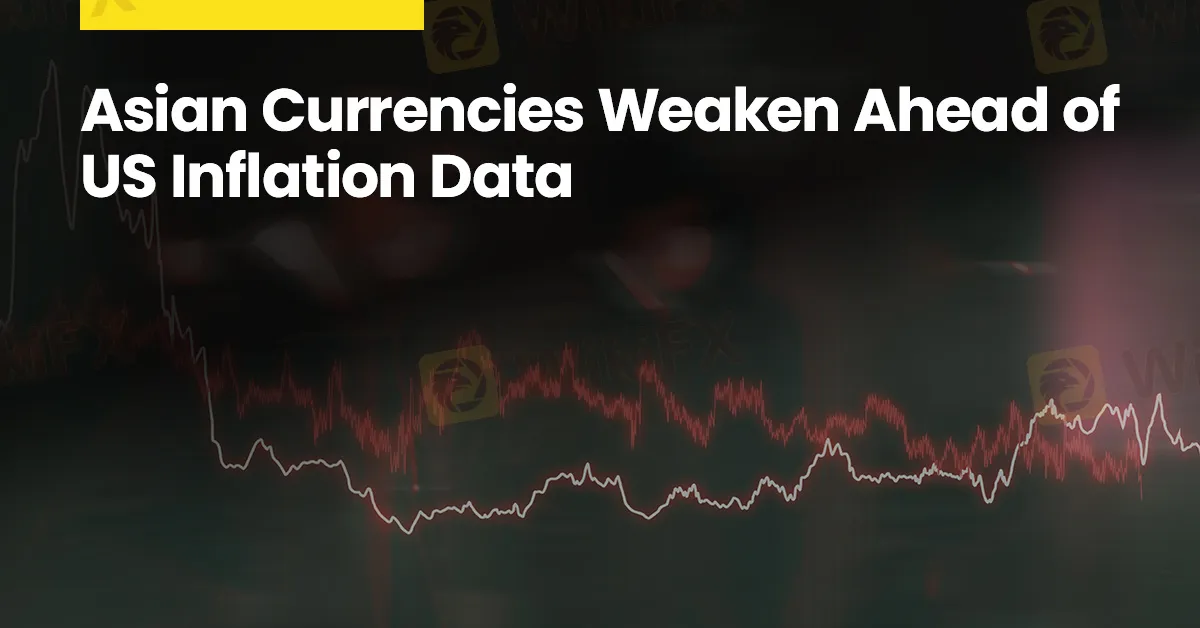简体中文
繁體中文
English
Pусский
日本語
ภาษาไทย
Tiếng Việt
Bahasa Indonesia
Español
हिन्दी
Filippiiniläinen
Français
Deutsch
Português
Türkçe
한국어
العربية
Asian Currencies Weaken Ahead of US Inflation Data
Abstract:Anticipation Builds as Federal Reserve's Policy Stance Hangs on Inflation Figures

Anticipation Builds as Federal Reserve's Policy Stance Hangs on Inflation Figures
Asian currencies faced downward pressure on Friday, while the US dollar stabilized as market participants awaited crucial inflation data that could influence the Federal Reserve's decisions on interest rates.
Despite a recent decline in the dollar following softer-than-expected US gross domestic product (GDP) data, which provided some respite for Asian currencies, persistent expectations of prolonged high interest rates in the US tempered any significant gains. The dollar also pared back some of its losses during Asian trading hours.
Japanese Yen Underperforms, USDJPY Reaches New Highs
The Japanese yen experienced weakness, with the USDJPY pair climbing above 156 to reach new 34-year highs after remarks from the Bank of Japan (BOJ) raised doubts about the central bank's capacity to further hike interest rates.
Although the BOJ opted to keep interest rates unchanged following a historic hike in March and projected higher inflation in the coming years, concerns over weaker economic growth in Japan cast doubt on its ability to continue raising rates, painting a predominantly dovish outlook for the yen.
Additionally, softer-than-expected consumer price index (CPI) inflation data from Tokyo, released earlier on Friday, added to skepticism regarding a hawkish stance from the BOJ.
However, fears of potential government intervention in currency markets limited yen losses, while an upcoming press conference featuring BOJ Governor Kazuo Ueda raised the possibility of more hawkish signals.
Broad Weakness Across Asian Currencies
Broader Asian currencies also faced depreciation on Friday amid ongoing concerns about prolonged high interest rates in the US. The USDCNY pair saw a slight uptick, remaining near recent five-month highs.
The USDKRW pair rose by 0.4% in South Korea, while the USDSGD pair gained 0.1% for the Singapore dollar.
Australian Dollar Supported by Inflation Data
The Australian dollar, represented by the AUDUSD pair, received support from robust producer price index (PPI) inflation data. Coupled with a higher CPI reading earlier in the week, this fueled expectations of extended high interest rates in Australia.
Indian Rupee Stable Amid Election Volatility
The Indian rupee, represented by the USDINR pair, saw limited movement as traders remained cautious amid the onset of the 2024 general elections in India, anticipating potential market volatility.
Focus on US Dollar Ahead of PCE Inflation Data
The US dollar index and dollar index futures posted marginal gains during Asian trading hours, recovering from overnight losses.
Although US GDP data indicated a cooler-than-expected growth rate in the first quarter, elevated inflation levels persisted, with the GDP price index surpassing expectations. As a result, market attention shifted to the upcoming Personal Consumption Expenditures (PCE) price index data, which serves as the Federal Reserve's preferred inflation gauge.
Despite Thursday's subdued GDP reading, traders gradually priced out expectations for imminent rate cuts by the Federal Reserve. The CME FedWatch tool now suggests that rate cuts are not anticipated until September or the fourth quarter of the year.

Disclaimer:
The views in this article only represent the author's personal views, and do not constitute investment advice on this platform. This platform does not guarantee the accuracy, completeness and timeliness of the information in the article, and will not be liable for any loss caused by the use of or reliance on the information in the article.
Read more

How Inflation Rates Affect Forex Prices Globally
In this article, we’ll explore how inflation affects forex prices globally, the relationship between inflation and currency value, and why traders monitor inflation closely.

Ringgit Retreats Against US Dollar Amid Profit-Taking
The Malaysian ringgit saw a slight retreat against the US dollar on Thursday, pulling back from its recent rally as investors cashed in profits following its substantial appreciation.

US Inflation Cools, But Economic Pressures Still Remain
Inflation shows signs of cooling in the U.S., but persistent economic pressures, particularly housing and utilities, continue to challenge growth.

Philippine PSEI Flat Amid July Inflation and Rate Concerns
Philippine PSEI ends flat as July inflation surge and rate hike concerns weigh on investor sentiment. Broader All Shares Index gains slightly.
WikiFX Broker
Latest News
CWG Markets Got FSCA, South Africa Authorisation
Amazon launches Temu and Shein rival with \crazy low\ prices
CySEC Warns Against Unauthorized Investment Firms in Cyprus
JUST Finance and UBX Launch Multi-Currency Stablecoin Exchange
XM Revamps Website with Sleek Design and App Focus
TradingView & Mexico’s Uni. Partnership, to Enhance Financial Education
Something You Need to Know About SogoTrade
Global Shift in Cryptocurrency Taxation: Italy and Denmark Chart New Paths
Webull Introduces 24/5 Overnight Trading to Extend U.S. Market Access
eToro Launches Global-Edge Smart Portfolio: A Balanced Approach to Growth and Stability
Currency Calculator


